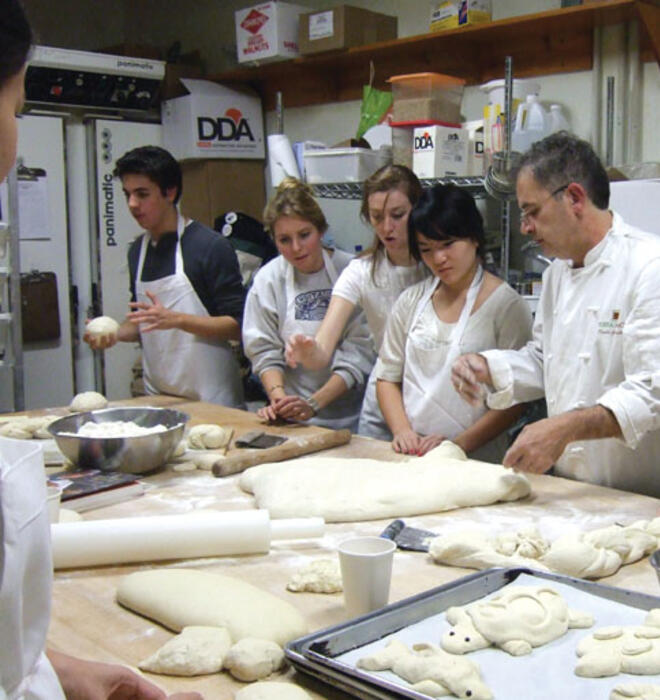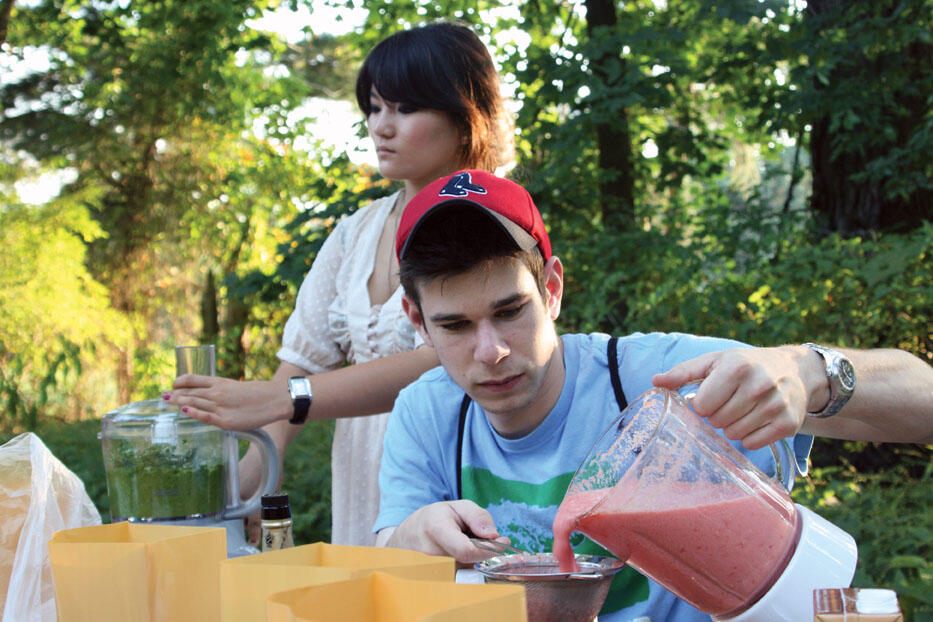
Think college cuisine means pizza, buffalo wings, and late-night chicken parmesan hoagies, eaten over textbooks amid pressing deadlines?
Not so for members of Slow Food Princeton, who kicked off the academic year in late September with a homemade dinner featuring Swiss chard pie, eggplant and pepper strata, and chilled tomato bisque, among other delicacies. Students prepared the meal largely from ingredients that they had grown and harvested in the University Garden Project, a bit north of Forbes College. They savored it al fresco, there in the garden.
Slow Food Princeton is one of 15 college and university campus chapters of Slow Food USA. All are part of the worldwide Slow Food International organization, which promotes “good, clean, and fair food.” In essence, the movement promotes eating and enjoying — this is key — food that tastes delicious, is produced in environmentally and socially responsible ways, and which does not harm human health or animal welfare.
“It’s all about understanding what you’re eating and the work that went into growing it, and being able to appreciate and savor food,” says Joseph Vellone ’10, the chapter’s president. “It’s also about forming personal connections to providers.”
The Princeton chapter was created in the fall of 2007, less than six months after Slow Food founder Carlo Petrini spoke on the Princeton campus. Petrini started his organization in 1996 in response to the opening of a McDonald’s in the Piazza di Spagna in Rome, hoping to limit the availability of fast food and boost local foods. For Petrini and his followers, gastronomy isn’t just about taste — it also concerns economics, history, anthropology, and environmental science. In 2004, he even started his own university in Italy to train the movement’s future leaders.
Working with members of the local agricultural and culinary scene, Slow Food Princeton is trying to raise awareness about Petrini’s “farm to fork” concept on campus. Five students were planning to attend the Slow Food International conference in Turin, Italy, last month. Last year’s events included bread-making workshops with chefs from the Witherspoon Bread Company as well as private tastings and French cooking classes. This fall, the group was scheduling more cooking and baking workshops, workdays at the Garden Project, and field trips to sustainable farms. Informally, group members often get together to cook with products bought at the campus farmers’ market that operates in Firestone Plaza in the spring and fall, or visit a favorite local spot for good food and good conversation.
For many of the Slow Food Princeton members, an interest in food long preceded their time on campus. Vellone, for instance, grew up in an Italian family, where “life revolved around food.” Yuanbo Liu ’10 is the daughter of oyster farmers in Oregon (oysters from the farm, the Oregon Oyster Farm in Yaquina Bay, were flown in last February for a Slow Food Princeton tasting) and Slow Food Princeton founding member Katy Andersen ’08 grew up on a farm in Pennsylvania.
“I think it’s unfortunate in our culture that many people have lost the pleasure of eating,” Liu says. “Instead, oftentimes, eating is done out of necessity and with much anxiety. It’s no longer an experience; when it is, it is a luxury. Slow Food, for me, is a way to realize again the pleasures of the table, the convivial experiences ... in a movement against the standardization of taste, which has far-reaching impacts across our world.”
After starting off with five students and growing to a membership of 100 students last year, Slow Food Princeton has more than doubled in size this year and now counts some 225 members. This dramatic growth parallels increased interest in food-related academic courses.
“I think the enthusiasm of the students should be encouraged,” says Slow Food Princeton’s faculty adviser, Pietro Frassica, a professor of French and Italian. “Students today are really aware of what’s going on with food, and they should be encouraged to talk about it.”
Frassica first tapped into the nascent student interest in food in the early 1990s, when he created his course on the “Literature of Gastronomy,” which quickly became immensely popular (see related article on page 24). Last year, recognizing the growing interest in the Slow Food movement on the Princeton campus, Frassica created an additional food course: “Italy: Land of Slow Food.” Much to the students’ delight (and to Frassica’s), the seminar included a weeklong tour through the Piedmont region of Italy and a meeting with Slow Food founder Petrini himself, who happens to be an old friend of the professor.
Highlights of that trip were visits to a working gristmill, a session with a traditional cheese-maker, and a “futurist cuisine” dinner at the Lacerba restaurant in Milan.
The menu that evening followed the guidelines laid out in 1932 in La Cucina Futurista, a culinary manifesto by Futurist movement founder Filippo Tommaso Marinetti that argued the presentation of food could influence human behavior, so the meal was designed to be aesthetically pleasing and to stimulate the senses and appetite. The fare included a ball of white risotto served over spinach in a cylinder to resemble a light bulb, and squares of swordfish accompanied by rounds of grilled apple and chopped lemon thyme.
Andersen, who is now studying artisanal cheese-making on a Fulbright scholarship at Petrini’s University of Gastronomic Sciences in Pollenzo, took Frassica’s Slow Food course and remembers the meal fondly. “Professor Frassica had invited some Milanese professors to dinner,” she recalls, “so we practiced our Italian and discussed the course while eating what we were essentially also studying.”







No responses yet